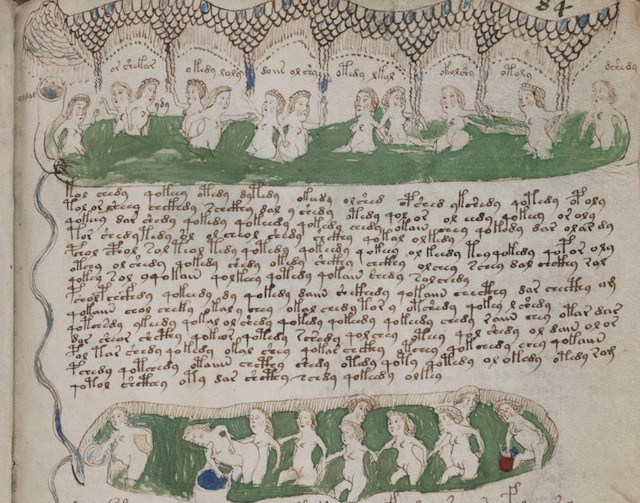Is the Voynich Manuscript Mexican? Scientists Say "Maybe," Ugh

Have you heard of the Voynich Manuscript? Otherwise known as the best manuscript-based mystery in the entire world? If you haven’t, read the Wikipedia page, which in its own right is a stellar #longread, but if you want a #shortread, okay, here it is, so you can beef up before learning about the newest plot twist in this mystery.
The Voynich Manuscript is a mysterious illuminated manuscript, meaning a manuscript with pictures drawn in it. It is written in a language that has not only never been translated, it has never even been identified. The vellum pages have been carbon-dated to the early 15th century, though most of its history is unknown and its contents are bizarre. It has a section about botany, complete with drawings of plants, but none of the plants have ever been identified in real life. There are sections about astrology that sort of resemble astrological symbols we’re familiar with, but sometimes do not. There’s one section that’s just drawings of naked women in complicated bathtubs.
The language is maybe the most amazing part. Military cryptographers have been unable to figure out the language at all. It has the linguistic trademarks of a natural language; a finite list of characters, some of which have to appear in each word (vowels, we think), some of which can be doubled or even tripled, some of which cannot. The structure of words, sentences, and paragraphs are vaguely Germanic, but it also has some similarities to Semitic languages like Hebrew and Arabic; certain characters only appear at the beginning or end of words, unlike in European languages. There are doubled and tripled words in a row, which occur basically never in Western languages but at a similar frequency to the Voynich Manuscript in languages like Vietnamese and Thai. Experts have proposed that it’s written in a strange dialect of anything from Northern Germanic to Manchu.
Many have assumed that it’s a cipher or code, but the world’s top cryptographers haven’t managed to crack it. It theoretically could be a hoax, but what a strange hoax it would be; handwriting experts have declared the pattern of quill strokes to be indicative of someone writing naturally, not thinking about, say, how to invent the next character. Even so, everyone from Roger Bacon to an array of 15th-century nutball alchemists have been suggested as possible hoax creators. An unprovable theory holds that it’s the result of channeling, the life’s work of a person who believes he’s writing the words of angels, or something like that. But the plausible number and arrangement of the characters and words makes it sort of unlikely that, you know, a crazy person did it.
In a very fun new development, botanist Arthur Tucker of Delaware State University has proposed that the botanical section actually depicts plants from the New World — specifically the territories ranging from Texas to California down to modern Nicaragua. He further proposes that the mysterious language could be a never-before-seen and now-extinct written version of Nahuatl, the language spoken by the Aztec and Toltec peoples (and currently by the Nahua indigenous population of central Mexico). Tucker connected 37 of the 303 plants depicted in the Voynich Manuscript to plants that would have grown in central Mexico in the 15th century, along with six animals and one mineral.
Of course, it’s hard to really analyze plants drawn 600 years ago; one expert points out that if you just made up a plant, you could probably find a real-life plant that looks like it. But who knows! Not scientists, that’s for sure.
The Voynich Manuscript is currently in Yale University’s collection, if anyone here is an expert in extinct Nahuatl dialects and wants to take a road trip to New Haven.
Photo from Wikimedia Commons
